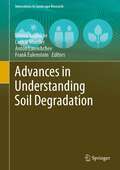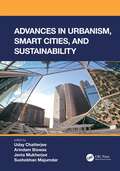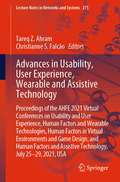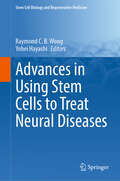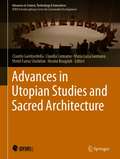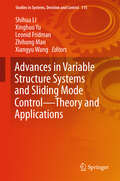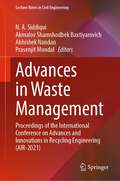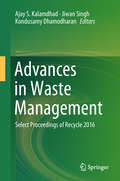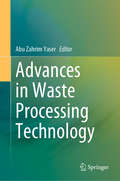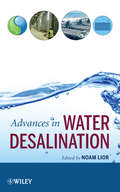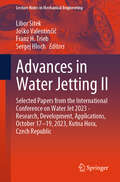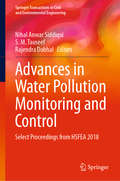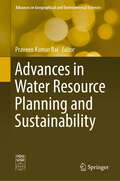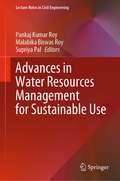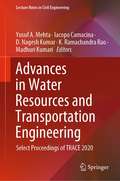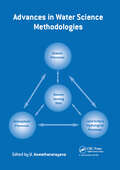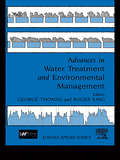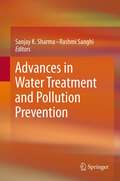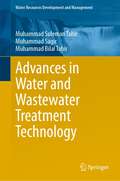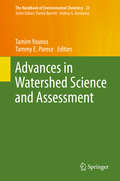- Table View
- List View
Advances in Understanding Soil Degradation (Innovations in Landscape Research)
by Lothar Mueller Frank Eulenstein Elmira Saljnikov Anton LavrishchevThis book informs about knowledge gain in soil and land degradation to reduce or prevent it for meeting the mission of the Sustainable Developments Goals of the United Nations. Essence, extent, monitoring methods and implications for ecosystem functioning of main soil degradation types are characterized in overview chapters and case studies. Challenges, approaches and data towards identification of degradation in the frame of improving functionality, health and multiple ecosystem services of soil are demonstrated in the studies of international expert teams. The book consists of five parts, containing 5–12 single chapters each and 36 in total. Parts are explaining (I) Concepts and Indicators, (II) Soil Erosion and Compaction, (III) Soil Contamination, (IV) Soil Carbon and Fertility Monitoring and (V) Soil Survey and Mapping of Degradation The primary audience of this book are scientists of different disciplines, decision-makers, farmers and further informed people dealing with sustainable management of soil and land.
Advances in Understanding the Biology of Halophilic Microorganisms
by Russell H. VreelandThis book is designed to be a long term career reference. The chapters present modern procedures. This is a how-to-book with a difference. These chapters: - reveal the background information about working with salt loving organisms, - are loaded with information about how experiments are conducted under high salt, - provide information about analyses that work under these conditions and those that may not, - present a wide range of details from laboratory designs to equipment used and even to simple anecdotal hints that can only come from experience. Microbiological training focuses largely on the growth, the handling and the study of the microbes associated with humans and animals. Yet the largest proportion of the Earth's microbiota lives in saline environments such as the Oceans, saline deserts and terminal hypersaline environments. This need for salt can be intimidating for those interested in entering the field or for those interested in understanding how such research is accomplished.
Advances in Urbanism, Smart Cities, and Sustainability
by Uday ChatterjeeWhile technology is developing at a fast pace, urban planners and cities are still behind in finding effective ways to use technology to address citizen’s needs. Multiple aspects of sustainable urbanism are brought together in this book, along with advanced technologies and their connections to urban planning and management. It integrates urban studies, smart cities, AI, IoT, remote sensing, and GIS. Highlights include land use planning, spatial planning, and ecosystem-based information to improve economic opportunities. Urban planners and engineers will understand the use of AI in disaster management and the use of GIS in finding suitable landfill sites for sustainable waste management. Features Explains the process of urban heritage conservation, including the process of urban renewal and its regeneration and the role of citizens in urban renewal, planning, and management. Includes several case studies highlighting urban environmental problems and challenges in developed and developing countries and the ways for converting urban areas into smart cities. Focuses on urban resources, the supply of energy in smart cities, and their proper management practices. Introduces the role of remote sensing, GIS, and IoT in making a smart city and meeting sustainable goals. Analyzes unique case studies, their challenges and obstacles, and proposes a set of factors to understanding smart city initiatives and projects.
Advances in Usability, User Experience, Wearable and Assistive Technology: Proceedings of the AHFE 2020 Virtual Conferences on Usability and User Experience, Human Factors and Assistive Technology, Human Factors and Wearable Technologies, and Virtual Environments and Game Design, July 16-20, 2020, USA (Advances in Intelligent Systems and Computing #1217)
by Tareq Ahram Christianne FalcãoThis book addresses emerging issues in usability, interface design, human–computer interaction, user experience and assistive technology. It highlights research aimed at understanding human interactions with products, services and systems and focuses on finding effective approaches for improving the user experience. It also discusses key issues in designing and providing assistive devices and services for individuals with disabilities or impairment, offering them support with mobility, communication, positioning, environmental control and daily living. The book covers modeling as well as innovative design concepts, with a special emphasis on user-centered design, and design for specific populations, particularly the elderly. Further topics include virtual reality, digital environments, gaming, heuristic evaluation and forms of device interface feedback (e.g. visual and haptic). Based on the AHFE 2020 Virtual Conference on Usability and User Experience, the AHFE 2020 Virtual Conference on Human Factors and Assistive Technology, the AHFE Virtual Conference on Human Factors and Wearable Technologies, and the AHFE 2020 Virtual Conference on Virtual Environments and Game Design, held on July 16–20, 2020, it provides academics and professionals with an extensive source of information and a timely guide to tools, applications and future challenges in these fields.
Advances in Usability, User Experience, Wearable and Assistive Technology: Proceedings of the AHFE 2021 Virtual Conferences on Usability and User Experience, Human Factors and Wearable Technologies, Human Factors in Virtual Environments and Game Design, and Human Factors and Assistive Technology, July 25-29, 2021, USA (Lecture Notes in Networks and Systems #275)
by Tareq Z. Ahram Christianne S. FalcãoThis book addresses emerging issues in usability, interface design, human–computer interaction, user experience and assistive technology. It highlights research aimed at understanding human interactions with products, services and systems and focuses on finding effective approaches for improving the user experience. It also discusses key issues in designing and providing assistive devices and services for individuals with disabilities or impairment, offering them support with mobility, communication, positioning, environmental control and daily living. The book covers modeling as well as innovative design concepts, with a special emphasis on user-centered design, and design for specific populations, particularly the elderly. Further topics include virtual reality, digital environments, gaming, heuristic evaluation and forms of device interface feedback (e.g. visual and haptic). Based on the AHFE 2021 Conferences on Usability and User Experience, Human Factors and Wearable Technologies, Human Factors in Virtual Environments and Game Design, and Human Factors and Assistive Technology, held virtually on 25–29 July, 2021, from USA, this book provides academics and professionals with an extensive source of information and a timely guide to tools, applications and future challenges in these fields.
Advances in Using Stem Cells to Treat Neural Diseases (Stem Cell Biology and Regenerative Medicine #77)
by Raymond C.B. Wong Yohei HayashiThis book dives into the forefront of stem cell research, uncovering the tremendous potential of stem cell technology for neural regeneration. This comprehensive volume offers valuable insights into diverse strategies for using stem cells to study neurodegenerative and neurodevelopmental disorders, as well as advances in research of neural regeneration strategies. Advances in Using Stem Cells to Treat Neural Diseases includes a collection of chapters carefully curated by leading experts in the field. These chapters explore the progress made in stem cell research and highlight recent advances in cell reprogramming and tissue engineering to develop disease modeling and regenerative therapy for the study and treat neural disorders. This book offers an unparalleled snapshot of the current landscape of stem cell research and an overview of up-and-coming technologies that could revolutionize the field. This unique resource would provide an important reference for stem cell biologists, neuroscientists, tissue engineers, molecular biologists, as well as students, academics and clinicans with an interest in neural regeneration
Advances in Utopian Studies and Sacred Architecture (Advances in Science, Technology & Innovation)
by Hocine Bougdah Claudio Gambardella Claudia Cennamo Maria Luisa Germanà Mohd Fairuz ShahidanAt a time dominated by the disappearance of Future, as claimed by the French anthropologist Marc Augé, Utopia and Religion seem to be two different ways of giving back an inner horizon to mankind. Therefore this book, on the one hand, considers the importance of utopia as a tool and how it offers an economic and social resource to improve cities’ wealth, future and livability. On the other, it explores the impact of religious and cultural ideals on cities that have recently emerged in this context. Based on numerous observations, the book examines the intellectual legacy of utopian theory and practices across various academic disciplines. It also presents discussions, theories, and case studies addressing a range of issues and topics related to utopia.
Advances in Vagal Afferent Neurobiology (Frontiers in Neuroscience)
by Bradley J. Undem Daniel WeinreichTaking a comprehensive approach in which all aspects of the vagal afferent system are considered, this extensive text reviews the development, neurochemistry, anatomy, biophysics, pharmacology, and physiology of the vagal afferent nerves. The authors present experimental techniques used to investigate the development, morphology, electrophysiology and reflex function of the vagal afferent nerves, and include state-of-the-art reviews of vagal afferent neurobiology by some of the world's leading experts in these fields.
Advances in Variable Structure Systems and Sliding Mode Control—Theory and Applications: Theory And Applications (Studies in Systems, Decision and Control #115)
by Xiangyu Wang Leonid Fridman Xinghuo Yu Shihua Li Zhihong ManThis book reflects the latest developments in variable structure systems (VSS) and sliding mode control (SMC), highlighting advances in various branches of the VSS/SMC field, e. g. , from conventional SMC to high-order SMC, from the continuous-time domain to the discrete-time domain, from theories to applications, etc. The book consists of three parts and 16 chapters: in the first part, new VSS/SMC algorithms are proposed and their properties are analyzed, while the second focuses on the use of VSS/SMC techniques to solve a variety of control problems; the third part examines the applications of VSS/SMC to real-time systems. The book introduces postgraduates and researchers to the state-of-the-art in VSS/SMC field, including the theory, methodology, and applications. Relative academic disciplines include Automation, Mathematics, Electrical Engineering, Mechanical Engineering, Instrument Science and Engineering, Electronic Engineering, Computer Science and Technology, Transportation Engineering, Energy and Power Engineering, etc.
Advances in Vision Research, Volume IV: From Basic to Translational Research — Developing Diagnostics and Therapeutics for Genetic Eye Diseases (Essentials in Ophthalmology)
by Gyan Prakash Takeshi IwataThis fourth volume in the series Advances in Vision Research describes importance advancements in basics to translational research, including new therapeutics for genetic eye diseases. Recent US FDA approval of the first gene therapy for an inherited retinal disease, due to a mutation in the RPE65 gene, has led to an upsurge in translational eye research. The coverage in this volume includes corneal diseases, myopia, cataract, glaucoma, inherited retinal diseases, inherited optic neuropathy, and other genetic eye diseases. New developments such as the application of artificial intelligence in translational eye research are also discussed. All chapters are written by leading researchers working on eye genetics from the fields of Human Genetics, Ophthalmology, Molecular Biology, Biochemistry, Sensory Sciences, and Clinical Research. Advances in Vision Research, Volume IV will be a major resource for all researchers, clinicians, clinical researchers, andallied eye health professionals with an interest in eye diseases around the globe. The first two volumes in the series described the state of the art in genetic eye research in Asia and the Pacific while the third focused on progress in Europe and the United States.
Advances in Waste Management: Proceedings of the International Conference on Advances and Innovations in Recycling Engineering (AIR-2021) (Lecture Notes in Civil Engineering #301)
by N. A. Siddiqui Prasenjit Mondal Akmalov Shamshodbek Baxtiyarovich Abhishek NandanThis book comprises papers from the International Conference on Advances and Innovations in Recycling Engineering (AIR-2021). It highlights indispensable issues, challenges, and recommended solutions related to solid waste management and sustainability. The contents deal with recommended solutions and the gap between environmental laws related to recycling of waste and environment threat. Weighing the global economy loss via compromises on industrial growth versus environment provides another dimension to the study and press on the need for alternative practices. The impact on biodiversity conservation and natural resources pollutants is also highlighted. This book will be a useful guide for academics, researchers, and policymakers working in the fields of waste management.
Advances in Waste Management: Select Proceedings of Recycle 2016
by Ajay S. Kalamdhad Jiwan Singh Kondusamy DhamodharanThis book presents some of the latest technologies in waste management, and emphasizes the benefits that can be gained from the use of recycled products. Divided into four sections, it deals with phytoremediation, acquatic weed management and the treatment of solid- and water-based wastes, such as those arising from agricultural, industrial and medical activities. With its special emphasis on the utilization of recycled products, this volume will be of interest to students, academicians, policy makers and others who have a practical and academic interest in dealing with the waste society generates.
Advances in Waste Processing Technology
by Abu Zahrim YaserThis book highlights the latest research on waste processing technologies, particularly for domestic, agricultural, and petroleum based pollutants, intended to achieve waste valorisation. In addition, it discusses the important role of plastic recycling, as well as advanced waste processing techniques.
Advances in Waste-to-Energy Technologies
by Rajeev Pratap Singh Vishal Prasad Barkha VaishAs global populations continue to increase, the application of biotechnological processes for disposal and control of waste has gained importance in recent years. Advances in Waste-to-Energy Technologies presents the latest developments in the areas of solid waste management, Waste-to-Energy (WTE) technologies, biotechnological approaches, and their global challenges. It combines biotechnological procedures, sophisticated modeling, and techno-economic analysis of waste, and examines the current need for the maximum recovery of energy from wastes as well as the associated biotechnological and environmental impacts. Features: Presents numerous waste management practices and methods to recover resources from waste using the best biotechnological approaches available. Addresses the challenges, management, and policy issues of waste management and WTE initiatives. Includes practical case studies from around the world. Serves as a useful resource for professionals and students involved in cross-disciplinary and trans-disciplinary research programs and related courses. Discusses the economic and regulatory contexts for managing waste. This book will serve as a valuable reference for researchers, academicians, municipal authorities, government bodies, waste managers, building engineers, and environmental consultants requiring an understanding of waste management and the latest WTE technologies.
Advances in Water Desalination (Advances in Water Desalination #1)
by Noam LiorDesalination is a dynamically growing field with more research, more engineering, more applications, more countries, more people, and with more training programs. This book provides high quality invited reviews on progress in various aspects of the desalination field. It features comprehensive coverage of desalination science, technology, economics, markets, energy considerations, environmental impact, and more. It is a key guide for professionals and researchers in water desalination and related areas including chemical, mechanical, and civil engineers, chemists, materials scientists, manufacturers of desalination membranes, water reuse engineers, and water authorities, as well as students in these fields.
Advances in Water Jetting II: Selected Papers from the International Conference on Water Jet 2023 - Research, Development, Applications, October 17-19, 2023, Kutna Hora, Czech Republic (Lecture Notes in Mechanical Engineering)
by Sergej Hloch Libor Sitek Joško Valentinčič Franz H. TriebThis book gathers selected, peer-reviewed contributions to the international conference on Water Jet 2023 (WJ2023), organized by the Institute of Geonics of the Czech Academy of Sciences. It covers research and developments of water jets, and their applications in cutting, machining, cleaning, surface treatment, and milling. Further topics include the use of water jets in the removal of coatings and layers, jet grouting, jet observation and parameters measurement. Moreover, erosion wear, environmental aspects of water jets and their improvement with particular emphasis on sustainable practices, are also discussed. Overall, this book provides academics and practitioners with extensive information on state-of-the-art theories and methods that can be used to understand, analyse and improve the rapidly growing field high-velocity water jet technology.
Advances in Water Pollution Monitoring and Control: Select Proceedings from HSFEA 2018 (Springer Transactions in Civil and Environmental Engineering)
by S. M. Tauseef Nihal Anwar Siddiqui Rajendra DobhalThis book presents the proceedings of the International Conference on Health, Safety, Fire, Environment, and Allied Sciences (HSFEA 2018), highlighting the latest developments in the field of science and technology aimed at improving health and safety in the workplace. The volume comprises content from leading scientists, engineers, and policy makers, discussing water pollution and advanced remedial measures, and the impact on health and the environment. Topics of discussion include research on emerging water pollutants, their sources, monitoring and control. The contents of this volume will be of interest to researchers, practitioners, and policy makers alike.
Advances in Water Resource Planning and Sustainability (Advances in Geographical and Environmental Sciences)
by Praveen Kumar RaiSustainable water resources planning deals with the interface of water resources science and the needs of human populations. It highlights works that addresses practical methods and basic research in, for example: quantity and quality management of groundwater and surface water resources; sustainability of water resources and water availability; water use and reuse including managed aquifer recharge and storage; geopolitical and socio-economic aspects of water resource management; water development and human activity impacts on ecological systems and human health, including, for instance, agricultural and climatic impacts, subsurface waste storage and injection, geothermal energy development and subsurface energy storage. This book provides up-to-date systematic and scientific analyses of such water problems and suggests sustainable measures to overcome them through effective surface and sub-surface water resource management. It is immensely valuable to students, researchers, water resource managers, hydrologists and all those who are engaged or interested in any aspect of river water conservation and management of water resources.
Advances in Water Resources Management for Sustainable Use (Lecture Notes in Civil Engineering #131)
by Pankaj Kumar Roy Malabika Biswas Roy Supriya PalThis book presents the innovative ideas and technical expertise for the sustainable solution in the field of water resources. It covers various topics on sustainable water resources management under climate change where researchers and professionals have shared their experience, innovative ideas, issues, recent trends and future directions in field of water resources engineering, science and technology. This book culminates the importance of achieving the ways towards water security and espouse targets and measures that will allow the end-user to meet this challenge in conjunction. It is a compendium of research articles pertaining to the mitigation of water crisis, surface and groundwater management, watershed management and modelling, case studies related to wetland vulnerability, water pollution, water quality, extreme climate hazards and others issues and its sustainable diminution through ingenious ideas and technologies that will incur valuable information to the stakeholders in the society. Given its scope, this book will be useful for the researchers and professionals.
Advances in Water Resources and Transportation Engineering: Select Proceedings of TRACE 2020 (Lecture Notes in Civil Engineering #149)
by D. Nagesh Kumar Madhuri Kumari Yusuf A. Mehta Iacopo Carnacina K. Ramachandra RaoThis book comprises select proceedings of the International Conference on Trends and Recent Advances in Civil Engineering (TRACE 2020). The volume focuses on latest research works carried out in the area of water resources and transportation engineering. The topics include technological intervention and solution for water security, sustainability in water resources and transportation infrastructure, crop protection, resilience to disaster like flood, hurricane and drought, traffic congestion, transport planning etc. It aims to address broad spectrum of audience by covering inter-disciplinary innovative research and applications in these areas. It will be useful to graduate students, researchers, scientists, and practitioners working in water resources and transportation engineering domain.
Advances in Water Science Methodologies
by U. AswathanarayanaThis book is a useful guide to employing remote sensing data to explain and illustrate interactions between atmospheric, oceanic and hydrological processes, incorporating the latest developments in the field. A number of applications, such as water resources management, environmental monitoring, climate prediction, agriculture, and preparation
Advances in Water Treatment and Environmental Management: Proceedings Of The 1st International Conference
by Roger King George ThomasProceedings of the 1st International Conference, Lyon, France, 27-29 June 1990.This book presents the specialist and those less familiar with water treatment and environmental management with up to date information from a range of international workers. The conference was a forum at which interest groups representing the research community, water c
Advances in Water Treatment and Pollution Prevention
by Rashmi Sanghi Sanjay K. SharmaAdvances in Water Treatment and Pollution Prevention explores the most up-to-date studies in the field of water pollution. More specifically, this book examines the causes and effects of this threatening phenomenon and identifies the preventive measures that can be taken to contain, and even to defeat, water pollution worldwide. The papers gathered in this volume pinpoint the need to implement greener water treatments to prevent water pollution from impacting ecosystems, human well-being and economies any further. They also successfully outline the processes that have been studied, optimized and developed so far to sustain our environment. Advances in Water Treatment and Pollution Prevention will represent a valuable resource to academic researchers, students, institutions, environmentalists, and anyone interested in environmental policies aimed at safeguarding both the quality and the quantity of water.
Advances in Water and Wastewater Treatment Technology (Water Resources Development and Management)
by Muhammad Sagir Muhammad Bilal Tahir Muhammad Suleman TahirThis book highlights the several pollutants and their derivatives that exist in water and wastewater, such as pharmaceuticals, antibiotics, personal care products, heavy metals, pesticides, dyes etc., as a result of rapid urbanization and industrialization. Several part pollution is caused by nutrients, organics, and contaminants with low concentration but is highly toxic to human and aquatic environment. This book provides a holistic approach in terms of measurement, monitoring, and recent advances in treatment technologies for water and wastewater treatment and water reuse. The technologies involve the physio-chemical, biological and advanced oxidation processes in which they are modified or coupled with nanomaterials and/or newly developed products for improving the performance of the current treatment processes. In addition, the membrane processes include recent research on the removal of challenging chemicals by various membrane bioreactors and reverse osmosis processes.
Advances in Watershed Science and Assessment (The Handbook of Environmental Chemistry #33)
by Tamim Younos Tammy E. PareceThis volume offers concepts, methods and case studies of innovative and evolving technologies in the area of watershed assessment. Topics discussed include: (1) Development and applications of geospatial, satellite imagery and remote sensing technologies for land monitoring; (2) Development and applications of satellite imagery for monitoring inland water quality; (3) Development and applications of water sensor technologies for real-time monitoring of water quantity and quality; and (4) Advances in biological monitoring and microbial source tracking technologies. This book will be of interest to graduate students and researchers involved in watershed science and environmental studies. Equally, it will serve as a valuable guide to experts in government agencies who are concerned with water-availability and water-quality issues, and engineers and other professionals involved in the design of land- and water-monitoring systems.
